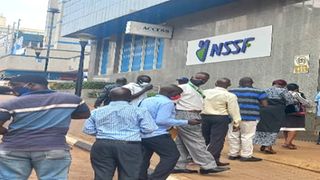
NSSF members line up at Workers' House in Kampala to apply for the 20 per cent mid-term access of their savings on March 7, 2022. The mid-term cash is for people who have saved with the Fund for 10 years and are above 45 years of age. PHOTO/ STEPHEN OTAGE
|National
Prime
Details emerge on new NSSF benefits
What you need to know:
- NSSF has now opened new windows to take care of people who might not be formally employed but wish to save with the Fund.
Whereas the discourse that gripped the nation has been about partial mid-term access of National Security Social Fund (NSSF) benefits, to the Fund managers, the meaty provisions in the amended law are elsewhere.
That issue of qualifying members getting up to 20 percent - or 50 percent, if impaired - of their benefits is settled both in law and practice.
And eligible mid-quadragenarians began applying for the benefit yesterday, with the first of planned weekly payments to be wired to individual bank or mobile money accounts on March 17.
ALSO READ: NSSF tests pay system, midterm claims start
Total pay-out is expected to gross Shs1t which, added to the regular members’ annual claims, will mean NSSF cash outflows will for the first time outstrip inflows by about Shs300b.
The mid-term debate was attention-arresting because under the old NSSF law, members could only access their benefits after clocking 50 years, if unemployed then, and or 55, the eligibility age, or if they became invalid.
In the alternative, survivors picked the benefits upon a member’s death.
ALSO READ: Workers speak out on mid-term access rules
However, an amendment to the workers’ pension legislation that Parliament enacted last November, and which President Museveni assented to on January 4, has ended in smiles and win-win for stakeholders, despite the initial rancorous debate about the proposals.
“The NSSF pre-2021 and the NSSF post-2022 are different”, Managing Director Richard Byarugaba declared yesterday during a dialogue with the media fraternity at Kampala Serena Hotel.
Mid-term beneficiaries will by the end of this year have walked away with Shs1t, which is expected to spur economic activity and, on the downside, likely stir inflation --- a liquidity glut that is Bank of Uganda’s headache to manage.
However, the Fund projects that inclusion of new savers in the scheme will rake in Shs90b per month in addition to the current Shs100b contributory remittances.
This is because more Ugandans now qualify to save with NSSF. Why? The revised law redefined an “employer”, which previously meant an entity with at least 5 employees, to include the government, informal, small and medium scale businesses, duly registered partnerships, trustees and managers and sub-contractor employees.
Thus, bureaucrats who have traditionally qualified for Public Service ministry-administered pensions, can in addition now elect to contribute to NSSF as can accountants, advocates and any individual interested in voluntary savings with the Fund.
Section 13(1) of the NSSF (Amendment) Act, 2021, provides that a member of the Fund can contribute “over and above” the standard 5 percent of their monthly salary, which will be matched with the employer’s existing 10 percent remittance.
The new law allows self-employed individuals to apply to be NSSF members and empowers the Fund board, in consultation with the line minister(s), and by statutory instrument, to introduce “additional benefits” for savers.
And yesterday, Mr Byarugaba said education, health and housing are some of the likely new benefits to come.
Without delving into much detail, Mr Byarugaba floated the idea of unit trusts, defined by Investopedia as an “unincorporated mutual fund structure that allows funds to hold assets and provide profits that go straight to individual unit owners instead of reinvesting them back into the fund”.




